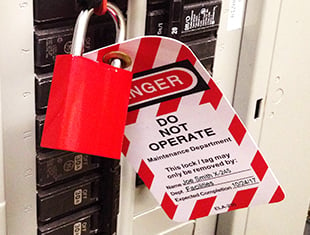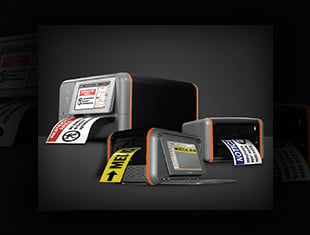Labeling for Arc Flash Hazards
03
February,
2023
6 MINUTE READ
Webinar | Labeling for Arc Flash Hazards
Labeling for Arc Flash Hazards
Protect yourself and your workers from arc flash. Compliance Specialist Brian McFadden outlines the labeling requirements from OSHA and the 2021 edition of NFPA 70E, along with the impact of the 2018 revision of IEEE 1584, and key points for improving electrical safety through visual communication.
 20 mins
20 mins Presented By

Brian McFadden
Technical Writer
Compliance Specialist
Transcript
Webinar Preview
Contents of the Labeling for Arc Flash Hazards Webinar:
- Why Labels?
- Preparing for Labeling
- Contents of an Effective Arc Flash Label
- What Is Needed to Make Labels?
Excerpt from the Labeling for Arc Flash Hazards Webinar transcript:
Why Labels?
First, why are we talking about labels at all? What's our goal here?
Safety through Information
In short, safety is the goal. Arc flash is a powerful and dangerous phenomenon, and by the time a flash begins, it's too late to change what you're doing. To be safe, workers need to be prepared - and to be prepared, they need to be informed.
Providing that information, where and when it's needed, is a big step toward preventing accidents and minimizing the damage they can cause. The right knowledge can save lives. That's what these labels and signs are for.
Legal Requirements
Arc flash hazard labels are also required by workplace safety laws. In the United States, OSHA will be looking for these labels.
Mark Equipment Ratings as Necessary
On the very basic end, OSHA requires electrical equipment in the workplace to be marked with "voltage, current, wattage, or other ratings as necessary."
This starts with manufacturer labels, but it doesn't end there. Employers are responsible to provide the information needed for the use and maintenance of the equipment.
Warn Workers of Electrical Hazards
OSHA gets more specific when it comes to hazards. Specifically, the law mandates the use of safety signs to " warn and protect employees from hazards which could cause injury due to electric shock, burns, or failure of electric equipment parts."
This clearly includes arc flash hazards, so labels or signs that warn workers about those hazards are necessary.
Inform Workers of Necessary PPE
Wherever a workplace hazard requires personal protective equipment (PPE), another OSHA requirement comes into play. Employers must determine what PPE is needed, provide that equipment, and communicate the necessary information to employees.
Working safely in the presence of an arc flash hazard requires PPE, so this rule also applies. For the communication part of the rule, labels are a simple and effective solution.
General Duty to Provide a Safe Workplace
Finally, there's what OSHA calls the "General Duty Clause." This is section 5(a)(1) of the Occupational Safety and Health Act, the law created by Congress that gave OSHA most of its powers.
The General Duty Clause says that employers have a "general duty" to provide a safe workplace - that is, one without hazards that are likely to cause death or serious injury. In most cases, we can't totally eliminate arc flash hazards, but we can use safe work practices to protect workers and minimize the risk of serious injuries. The General Duty Clause is a guiding principle, and it brings us back around to the first reason we wanted to have arc flash labels. It's all in the interests of safety.
Preparing for Labeling
All right, so you need to protect your workers, and information through labeling is a big part of that protection. What exactly needs to be on an arc flash label for it to be effective?
This is where the National Fire Protection Association (or NFPA) comes in. Their standard for workplace electrical safety is NFPA 70E, and it describes accepted practices, based on expert opinions and industry consensus. NFPA 70E dedicates a lot of its content to the topic of arc flash safety, specifically including labels, and it requires these labels to include certain specific details that will inform safe choices when workers need to interact with the equipment. The requirements for these detailed labels are listed in Article 130.5(H), and I'll be sure to cover those requirements later.
Obtaining the Necessary Information
But before you can put detailed information on a label, you need to get that information from somewhere. NFPA 70E describes two methods to get the information that it requires: analysis and categories.
The Incident Energy Analysis Method
The analysis approach gives you exact details for your specific equipment in your specific installation. Using technical data and a variety of calculation methods, you can determine the expected incident energy for an arc flash.
Incident energy is the amount of heat energy that would hit a surface at a specified distance if an arc flash occurred. It's typically measured in calories per square centimeter. As an example, an incident energy of 1.2 calories per square centimeter is enough to cause second-degree burns - serious, but still treatable. Higher incident energy means more total heat is applied to the surface, and you see a more destructive result.
This energy spreads out as it gets farther from the arc, so increasing the distance will decrease the incident energy. As a result, it's critical to specify the distance you're using for your calculations. This should be the so-called "working distance" - that is, the distance from the equipment to a worker's face and chest. It's often estimated at 18 inches, but the actual distance may be more or less depending on the equipment, installation, and task involved.
This calculation approach gives detailed results, but can be complicated to use because it requires some complex math. There are several different calculation methods to choose from, as well. The method that's generally considered the best is one published by the Institute of Electrical and Electronics Engineers (or IEEE), in their standard called IEEE 1584. It was most recently updated in December of 2018, with revisions based on extensive experimental testing. If you've used another method in the past, including the 2002 version of the IEEE standard, that's no longer following the best available science. Keeping your information up to date may require revisiting the analysis.
While all the calculations can be done by hand, or in a spreadsheet, specialized electrical analysis software (like EasyPower) can make this approach much easier.
The PPE Category Method
The other approach is a shortcut. Instead of doing a lot of math based on the exact details of your equipment, you can simply read a set of tables that the NFPA has prepared. These tables assign broad categories to some common situations.
If your equipment and installation are covered in those tables, all you need to do is find the entry that applies, and you can use the published recommendations for the matching category. Each category (numbered 1 to 4) has an associated list of required PPE, along with minimum ratings for that protective gear. That's why this approach is called the Arc Flash PPE Category method.
The tables don't cover all situations, though, and if your installation isn't covered, the category system simply can't apply. You'll need to do an analysis.
Avoiding Confusion
In the past, a lot of people tried to use both systems at the same time, calculating the Incident Energy and then assigning an Arc Flash PPE Category as well. This has been specifically prohibited in NFPA 70E since the 2015 edition, and there are several reasons for this:
- The systems use different methods to come up with their recommendations. The PPE Categories are based on the NFPA's estimates for common situations, which have to be fairly conservative in order to apply to a useful range of situations; the Incident Energy calculations are up to the employer's detailed math for the exact equipment and installation being described, accounting for any protective systems or maintenance procedures that are in place.
- The two systems also give their results in different ways. A PPE Category of "4" means you need the maximum-protection "space suit" before you can work on the equipment safely; an Incident Energy of "4" means you need some standard thermal gear and a face shield, and you can leave all the heavy stuff in the tool room. A misunderstanding here could be deadly.
- Finally, equipment and installations can be changed over time, and the scientific understanding of arc flash is continuing to grow. In the future, you'll need to review and probably revise your arc flash safety systems. If you aren't sure where the old information came from, it will be impossible to verify it and hard to update it.
In general, if your project is fairly small or uses only common equipment, the category approach can save time and effort. For larger facilities or more specialized situations, analysis is probably called for.
NFPA 70E Equipment Labeling Elements
Let's say you've done your research, and you're ready to move forward. What does NFPA 70E actually require for its detailed arc flash warning labels? Article 130.5(H) lists the following elements:
. the Nominal System Voltage;
. the Arc Flash Boundary; and
. at least one of the following:
o the Incident Energy and Working Distance, or the Arc Flash PPE Category, but not both;
o the Minimum Arc Rating of clothing;
o and/or a site-specific identification of required PPE.
I've had a lot of questions about the details of these elements and the choices that are involved, so I'll briefly explain each part of the requirement.
Element 1 Nominal System Voltage
First, there's the nominal system voltage, or the "voltage class" for the equipment. This is usually the easiest detail to track down, and it serves as a quick and simple indicator for the power of a system.
To learn the about common types of visual signals, and practical guidance on maximizing the value of visuals in your facility, watch the full webinar on demand now!
RELATED RESOURCES

Electrical Safety with Lockout/Tagout
Webinar | Electrical Safety with Lockout/Tagout Electrical Safety with Lockout/Tagout Protect against ...
Watch Now
JHA for Facility Safety & Managing Hazards
Webinar | JHA for Facility Safety & Workplace Hazards JHA for Facility Safety & Managing Hazards ...
Watch Now
Getting Started with your DuraLabel Printer
Webinar | Getting Started with your DuraLabel Printer Getting Started with your DuraLabel Printer Become an ...
Watch Now.png)


